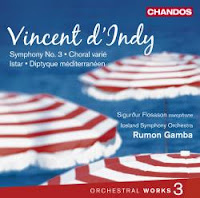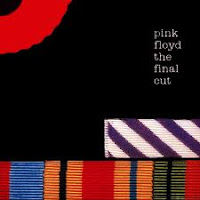Last week I spent largely listening to two lesser well known turn-of-the-century French symphonies: Chausson's
Symphony in B flat, op. 20 (finished in 1890) and Albéric Magnard's
Symphony nr. 3 in B flat minor, op. 11, composed in 1895/6.

Impressed as I was by Chausson's
Chant de l'Amour et de la Mer, and noting that I hardly knew any other music of his, I thought it worthwhile to investigate some of his other symphonic and chamber output. Recordings of his only symphony are far and few between so I settled on a Chandos disc with a performance by the BBC Philharmonic led by Yan Pascal Tortelier. The symphony is a late romantic extravaganza, richly harmonised, opulently scored and infused with an 'art nouveau' like melos of endlessly flowing lines. Wagner's chromatic footprint and somber (Tristan-inspired) orchestral colours are omnipresent as is César Franck's organic conception of symphonic form. Despite the evident architectural and atmospheric qualities of the music, the work did for me not really catch fire. Allegedly Chausson complained that during composition he agonised over each and every bar and in a way that struggle is transmitted to the listener. Every bar taken in isolation seems to have jewel-like qualities but the whole loses shape and turns into a big fortissimo blanket of suffocating ecstasy. One can also understand why Debussy mischievously (as was his custom) referred to Chausson's output as 'prison music'. It's altogether not a surprise why it hasn't found a more prominent place in the repertoire.
The highlight of this disc is, however, a delightful tone poem with the rather lapidary name
Viviane. It's Chausson's op. 5 and effectively constitutes his symphonic debut. The young composer wrote it in 1882 in homage to his wife-to-be Jeanne Escudier (who bore him five children). The story that inspired the work is drawn from Arthurian legends (Chausson must have been fascinated by them as later on he wrote an opera on the subject:
Le Roi Arthus). Viviane was a mistress of the sorcerer Merlin, who used one of his spells against him. Chausson provided the following synopsis at the head of the score: "Viviane and Merlin the forest of Brociliande. Love scene. Trumpet calls. King Arthur's messengers search the fortress for the sorcerer. Merlin remembers his mission. He wants to flee and escape Viviane's embrace. Enchantment scene. To retain him, Viviane puts Merlin to sleep surrounded by flowering hawthorns." All this is most colourfully and delicately evoked in a score that is appropriately Wagnerian in inspiration but musters perfect poise and restraint in the use of symphonic resources.
Soire de Fête, op. 32 was composed in Italy a year before Chausson's death (1899, in an unfortunate bicycle accident). Here one feels how he was loosening Wagner's grip and moving towards an idiom that leans towards Debussy. The tone poem is a study in two contrasting moods - festivity and contemplation - and in the livelier part it seems to connect to Debussy's
Fêtes (from the
Nocturnes; completed in 1899 and premiered only a year later; however Debussy and Chausson knew each other very well and Chausson must have been intimate with the
Nocturnes' long gestation period). That being said,
Soire de Fête has as much from Tchaikovsky (
Capriccio Italien) and altogether it didn't make a big impression on me.
Onwards to another composer which up to this point had been all but unknown to me. Well, not really unknown as the name 'Magnard' has been floating around in my subconscious for a long time. I can readily picture the sleeves of the LPs that were recorded in the 1980s by Michel Plasson and his Toulouse orchestra. Likely the proximity of 'Magnard' and 'Mahler' in library and CD shop racks has something to do with it. But whilst I knew the name I hadn't heard anything by Magnard. Recently I bought a double CD straight from Hyperion with all four CDs in the composer's output, performed by the BBC Scottish Orchestra led by the Jean-Yves Ossonce. The conductor's website learns us that he works primarily with third and fourth-tier orchestra in the French province and that he specialises somewhat in late 19th century French repertoire (Massenet, Ropartz, de Séverac). He has since 1997 made no other recordings with Hyperion.
I first listened to Magnard's 37-minute
Third Symphony in the car (which I rarely do but now it happened) on my way to and from Brussels. I was immediately captivated by the work's introduction of organum-like, solemn chords in the brass and winds. This sounded like something genuinely special. However, once the work got under way a certain disappointment set in. I was struck by the Schubertian insouciance of the work, by a certain pedestrianism in the choice of thematic material and the rather plain orchestration. True, there were some tantalising flashes that reminded of Bruckner (not surprising given the Schubertian echos) but the whole made a very uneven impression. However, since I have listened to the work five times and I must say it really got under my skin. It's a very peculiar and protean work. Now that I'm familiar with it it's much more the Franckian pedigree that comes to the fore (the cyclical form, the shape of the melodies, the church-like harmonies). And what is also striking is a certain limpidity that inevitably reminds me of Scandinavian music. One very remarkable instance comes at the end of the first movement which seems to come straight out of an early Nielsen symphony! Berwald is another composer that comes to mind. Whilst I can still see the occasional lapse into academism, the symphony as a whole now comes across as a coherent and inspired statement. One thing that continues to bother is the rhythmic and textural uniformity across the work's whole span. Not even the slow movement (Pastorale: Modéré) jumps out as its stormy middle section connects it with the introductory and closing allegros. But it's not a major detraction. Maybe the final movement is the one that has captivated me most. There is a very striking middle section in which the brass intone a mournful chorale, accompanied by very Brucknerian triplets in the strings, immediately followed by a mighty climax in the brass. This wonderful episode is repeated three times. Towards the end the mysterious introductory section returns providing a satisfying sense of closure.
I've also listened to the first movement of the
Fourth Symphony and this sounds even more promising. It seems more tightly woven and the orchestration is somewhat denser and more exotic. I look forward to digging into that very soon (I also have a very nice copy of the Plasson recording on LP to compare). The Hyperion recording initially disappointed me. I thought the sound too reverberant, blunting the dynamics and bite of the orchestral playing. However, this is one of the cases where listening with my headphones proved to be a more satisfying listening experience. Altogether Ossonce did a very decent job with the BBC Scottish. There's also a bargain priced set on Brilliant around with Vänska and the Malmö Symphony Orchestra. It is said to be significantly slower than the Hyperion version and I can't see what would be gained by that but I'll snap it up anyhow when it crosses my path. Altogether an interesting discovery!
 I discovered a potentially interesting dowload service in eClassical.com, ostensibly operating from Sweden. Pricing is per second so relatively short pieces can be had quite cheaply in 16-bit or 24-bit FLAC. The catalogue is still sparse, but with a selection of Chandos, BIS, BBC Legends and Da Capo albums, there is quite enough on offer.
I discovered a potentially interesting dowload service in eClassical.com, ostensibly operating from Sweden. Pricing is per second so relatively short pieces can be had quite cheaply in 16-bit or 24-bit FLAC. The catalogue is still sparse, but with a selection of Chandos, BIS, BBC Legends and Da Capo albums, there is quite enough on offer.



























